
Stuck on your plot? Not sure how to shape your scenes and chapters?
Here are a list of excellent resources to get your going again.
I’m not sure how I came across this checklist that Ms. Whitney encouraged writers to use as they crafted their stories, but I’m using it as I create my next story and I’m finding the checklist so helpful. I also love knowing that my beloved author used this to help her write her memorable characters and her stories.
Phyllis A. Whitney‘s Checklist for Creating a Great Story
1. Have you a plot, a story plan?
- Is your main character faced by a problem which is very important for him/her to solve?
- Is it a suitable problem for a person that age?
- Is it a problem which will interest others?
- Are there real obstacles in the path of your main character which prevent him or her from easily achieving his/her purpose or goal?
- Does your main character solve the problem satisfactorily at the end of the story?
2. Is your characterization sound?
- Are your characters real-like people whom readers can see and feel they know as individuals?
- Is the characterization consistent all the way through the story?
3. Does your story have significance?
- Do you have something to say that is important for people?
- Does your main character learn and change?
4. Are the various story parts satisfactorily handled?
- Does the opening grip the reader’s interest immediately?
- Does the action in the body of the story continue to be of absorbing interest to readers of the age you are trying to reach?
- Does the climax carry a real dramatic punch?
- Is the denouement (the end game) satisfying? Avoid leaving a bad taste. Unpleasant reality may often be included, but the conclusion should point constructively toward hope, if possible, and leave the reader satisfied that the ending is “right” or inevitable.
5. Have you kept to a single viewpoint throughout the story?
- Does the speech idiom as well as the thought idiom of your viewpoint character ring true all the way through the story?
6. Beginning to End
- Is your logic sound from beginning to end?
- Are you straining the reader’s credulity for the sake of the point you want to make? If you are, your story will fail. Just because you, the author, want something to be so, doesn’t necessarily mean that it logically is so.
7. Is your dialogue natural?
8. Have you included only such material as is absolutely relevant?
- Have you kept only essential sentences necessary to your plot development?
- Does all action, dialogue, characterization, description, help to move the story toward the climax?
9. Have you avoided the avoidables?
- Have you avoided the use of trite, hackneyed situations and phrases?
- Have you avoided the use of clichés?
10. Are your transitions quick and smooth?
11. Are your figures of speech suited to the subject and time of the story?
- Will they seem appropriate to the readers for whom you are writing?
12. Does the story have emotional value?
- Does it make your reader feel? (If it doesn’t, he or she might just as well go work a puzzle. The purpose of a story is to convey an emotional experience.
13. Does the story carry the illusion of a reality which makes it really seem to be happening, makes it convincing?
14. Can you check “yes” to items 1-13?
If you can answer “yes” to these questions, chances are you have a story that will sell.
Other Fiction-Writing Helpers
Susan May Warren’s Roadmap for Outlining Your Novel

Susan May Warren’s Roadmap for Outlining Your Novel
Susan May Warren’s Roadmap for Outlining Your Novel is based on her excellent course on novel-writing. In January 2016, Susan repackaged this series under “How to Write a Brilliant Novel.” The structure is much the same: a truly excellent way for you to outline your novel. The above graphic is its own checklist of sorts, to make sure you have covered the essential points as you outline your novel. Susan also provides a weekly (Thursday evenings) ongoing program for novels to come together and listen as Susan and her friend and best-selling author Rachel Hauck, help aspiring authors with their manuscripts. Learn more at Learn How to Write a Novel.
Techniques of the Selling Writer by Dwight V. Swain
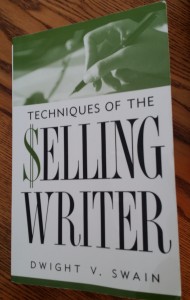 Swain’s, Techniques of the Selling Writer, is one of the best writing books I’ve read and keep within arm’s reach while I write. Here’s the table of contents: Fiction and You, The Words You Write, Plain Facts About Feelings, Conflict and How to Build It, Fiction Strategy, Beginning, Middle, End, The People in Your Story, Preparation, Planning, Production, Selling Your Stories, You and Fiction.
Swain’s, Techniques of the Selling Writer, is one of the best writing books I’ve read and keep within arm’s reach while I write. Here’s the table of contents: Fiction and You, The Words You Write, Plain Facts About Feelings, Conflict and How to Build It, Fiction Strategy, Beginning, Middle, End, The People in Your Story, Preparation, Planning, Production, Selling Your Stories, You and Fiction.
The section on the five essential elements of story (found on page 132 in my book version) is excellent: a. Character. c. Situation. c. Objective. d. Opponent. e. Disaster. Swain breaks down the complicated parts of crafting a story into simple yet concrete ways.
His section about Action and Reaction Scenes is just excellent and Swain provides great examples for you to translate into your own book.
Swain’s rules for what Action Scenes must do:
In Every Action Scene the focal character will have a goal, as will the other characters.
Every Action Scene must have an active event where there is a goal, a conflict, and a disaster.
At the end of every Action Scene, your character should be faced with a choice of some kind, some dilemma he or she has to solve.
Goal
These goals are not the character’s big-picture goals (aka her or his PURPOSE, but smaller goals).
Smaller goals must be:
- specific and clearly definable
- a proactive goal, something that makes our character alive and interesting. A character who wants something desperately is a interesting character-someone we want to know or emulate.
Goals can be derived from:
- by situation
- by character’s motivation
- of events happening around her/him
Conflict
Conflicts are the obstacles your POV faces on the way to reaching his goal. A scene without conflict is a boring scene.
Conflicts can be:
- internal (competing values)
- external
- in interpersonal relationships
- or against an external force
They must be visible to reader and equal in strength to the character’s motivation for completing the goal. A conflict that is too easily overcome isn’t a real conflict.
Disaster
Don’t let your character reach her goal. Winning is boring, except at the end. Even if there is a small victory with the goal, this victory must launch a new set of obstacles, even worse than before. So in the end, our character is in a worse place. Don’t ever end a scene with all the ends tied up. Leave the reader tense and worried.
Ask the following questions to get to disaster mode:
- What is the worst thing, externally (circumstance or physically) that could happen to my character?
- What is my character’s worst fear at the moment?
- What is the worst information my character can receive right now?
- What is the worst trouble my character can get into in this scene? Raise the stakes so that they are further from their overall goals.
- Have I set up the danger for the readers before the scene begins? (unexpected, yet plausible)
- Have I made my reader care about my character?
- Can they sympathize? (Spell out the stakes often enough so the reader worries!)
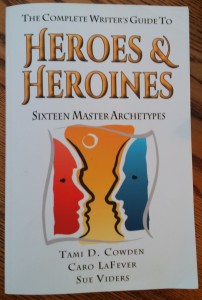 The Complete Writer’s guide to Heroes & Heroines: Sixteen Master Archetypes by Tami D. Cowden, Caro LaFever, and Sue Viders. From the core archetypes to pairing your archetypes to providing examples used in television, film, and literature characters, this book is nothing short of awesome.
The Complete Writer’s guide to Heroes & Heroines: Sixteen Master Archetypes by Tami D. Cowden, Caro LaFever, and Sue Viders. From the core archetypes to pairing your archetypes to providing examples used in television, film, and literature characters, this book is nothing short of awesome.
These three books are also must-haves:
 The Positive Trait Thesaurus: A Writer’s Guide to Character Attributes, by Angela Ackerman and Becca Puglisi
The Positive Trait Thesaurus: A Writer’s Guide to Character Attributes, by Angela Ackerman and Becca Puglisi
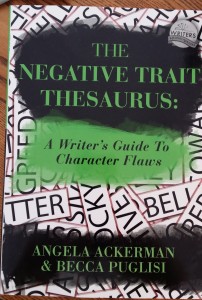 The Negative Trait Thesaurus: A Writer’s Guide to Character Attributes, by Angela Ackerman and Becca Puglisi.
The Negative Trait Thesaurus: A Writer’s Guide to Character Attributes, by Angela Ackerman and Becca Puglisi.
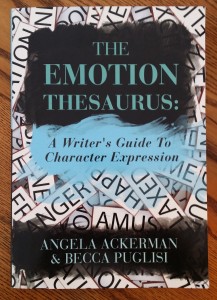 The Emotion Thesaurus: A Writer’s Guide to Character Expression, by Angela Ackerman and Becca Puglisi.
The Emotion Thesaurus: A Writer’s Guide to Character Expression, by Angela Ackerman and Becca Puglisi.
Vocabulary of Emotions
Attributing an emotion to each scene will help you as you write your chapters. Tom Drummond’s emotions list runs from light to strong emotions. The list is available on his site in pdf form at Vocabulary of Emotions.
Sense Words
This link of sense words relates to our five senses.
Here’s a sampling of touch words: Abrasive, feathery, knobbed, sandy, spongy, biting, fine, lacy, scalding, steamy, boiling, fluffy, leathery, scorching, steely, bubbly, foamy, light, scratchy, sticky, bulky, freezing, lukewarm, scummy, stifled, bumpy, furry, matted, shaggy, stinging, burning, fuzzy, gushy, pocked, smothering, ,prickly, pulpy, … You get the picture. Sense words is provided by the Services of Mission del Paso Campus.
Circle of Emotions and Feelings
This is a great little chart to aid you as you write you your beats.
What are some of your favorite resources that help you as you write to make a compelling read?
Julie
About Julie Saffrin
Julie Saffrin is the author of numerous published articles and essays. Her latest book, BlessBack: Thank Those Who Shaped Your Life, explores the power of gratitude and offers 120 creative ways to journey toward positive, lasting change.
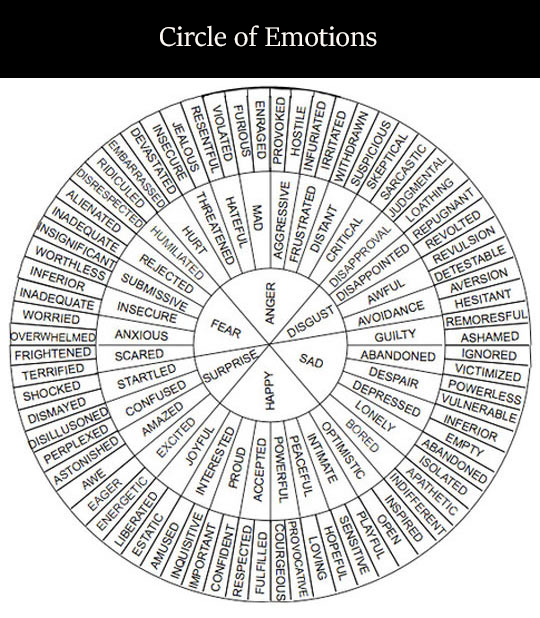
Tons of great info – thanks, Julie!